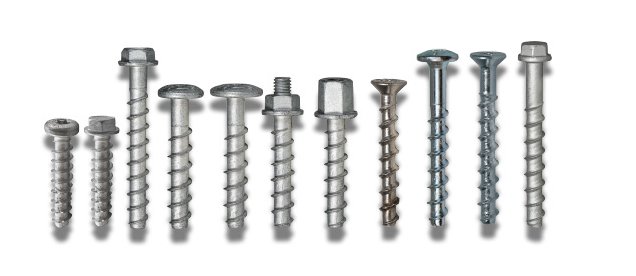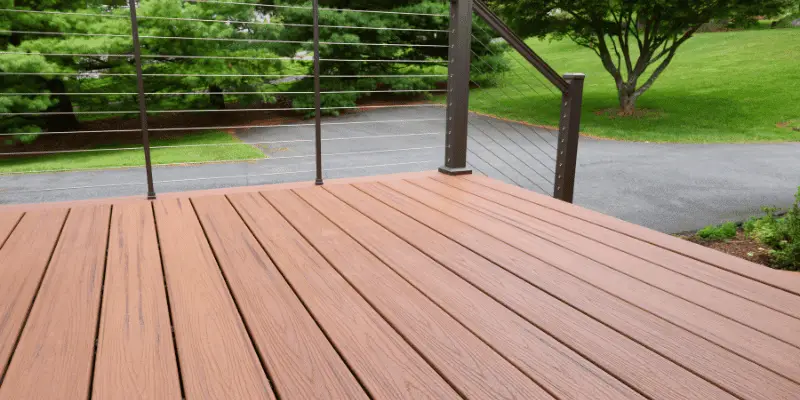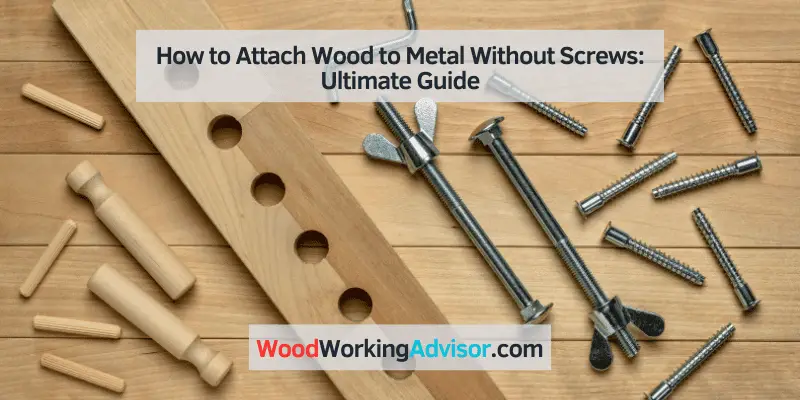To attach wood to metal without screws, you can use adhesives specifically designed for this purpose such as epoxy or construction adhesive which form a strong bond between the two materials. Additionally, you can use clamps or magnets to hold the wood in place while the adhesive sets.
These methods provide a secure and durable connection between wood and metal without the need for screws. By using adhesives or clamps, you can easily join wood and metal surfaces together for various applications such as furniture, artwork, or other DIY projects.
Say goodbye to screws and enjoy a seamless combination of wood and metal with these alternative attachment methods.
The Benefits Of Attaching Wood To Metal Without Screws
Discover the numerous benefits of attaching wood to metal without the need for screws. This efficient method provides a secure bond between the two materials while saving you time and effort. Whether it’s for DIY projects or professional construction work, this technique offers a reliable solution.
Wood and metal are commonly used materials in various DIY projects and construction. Traditionally, screws have been the go-to option for attaching wood to metal. However, there are alternative methods that offer numerous benefits. In this blog post, we will explore the advantages of attaching wood to metal without screws.
Whether you’re looking to enhance aesthetics, simplify installation, or reduce damage to materials, these techniques provide a versatile and practical solution for your projects.
Enhancing Aesthetics:
- Concealed fasteners: By using methods like adhesives, you can achieve seamless and visually appealing results, as there are no visible screws or fasteners on the surface.
- Minimalist design: Attaching wood to metal without screws can create a sleek and modern look, perfect for contemporary or minimalist aesthetics.
- Versatile finishes: Without screws, you have more freedom to experiment with different finishes, such as paint, stains, or varnishes, ensuring a cohesive and customized appearance.
Simplifying Installation:
- Time-saving: Alternative methods like adhesives or clamps can significantly reduce the time required for installation compared to screwing wood to metal.
- Easy adjustments: Unlike screws, where adjustments can be time-consuming and may require additional tools, attaching wood to metal without screws allows for easier and quicker modifications if needed.
- Simplified processes: Certain methods, such as using specialized brackets or metal connectors, offer straightforward installation procedures without the need for complex measuring, drilling, or screwing.
Reducing Damage To Materials:
- Avoiding splitting: One significant advantage of not using screws is the decreased risk of wood splitting. By opting for methods like adhesives or brackets, you can preserve the integrity of the wood surface.
- Minimizing metal damage: Traditional screwing can cause scratching or denting on metal surfaces. Choosing alternative attachment options ensures the metal remains unharmed, maintaining its aesthetic appeal and structural integrity.
- Protecting delicate materials: When working with delicate or fragile materials, securing wood to metal without screws eliminates the risk of damage that may occur during the screwing process.
The benefits of attaching wood to metal without screws are numerous. From enhancing aesthetics by eliminating visible screws to simplifying installation and reducing the risk of damage to materials, these methods provide efficient and effective alternatives to traditional screwing. Whether you’re a DIY enthusiast or a professional contractor, exploring these techniques can elevate your projects to new levels of functionality and visual appeal.

Credit: www.celofixings.com
Methods For Attaching Wood To Metal Without Screws
Discover effective methods to attach wood to metal without the use of screws. These alternative techniques provide secure and efficient solutions for connecting different materials, ensuring durability and stability in your projects.
Attaching wood to metal without screws can be a challenging task, but with the right methods, it is possible to achieve a strong and secure bond. In this section, we will explore several techniques for attaching wood to metal, ranging from using adhesives to welding and soldering, as well as magnetic mounting solutions.
Each method has its own advantages and considerations, so let’s dive in and explore the various options.
Adhesives
Using adhesives is a popular method for attaching wood to metal without screws. It offers simplicity and versatility, allowing for a strong bond between the two materials. Here are the steps for using adhesives to attach wood to metal:
Choosing the Right Adhesive:
- Select an adhesive specifically designed for bonding wood to metal.
- Look for adhesives that provide strong adhesion, durability, and resistance to temperature changes.
Surface Preparation:
- Ensure that both the wood and metal surfaces are clean and free from dust, grease, or any other contaminants.
- Sanding or roughening the surfaces can enhance adhesion.
Applying the Adhesive:
- Apply the adhesive evenly onto the metal surface, following the manufacturer’s instructions.
- Press the wood firmly against the metal and hold it in place for the recommended curing time.
Clamps And Brackets
Another method for attaching wood to metal is by using clamps and brackets. This technique offers stability and allows for easy disassembly if required. Here are the steps to follow when using clamps and brackets:
Selecting the Appropriate Clamps and Brackets:
- Choose clamps or brackets specifically designed for attaching wood to metal.
- Consider the size and weight of the wood and metal for proper support.
Positioning and Securing the Wood:
- Find the desired position for the wood on the metal and mark it.
- Attach the clamps or brackets to the metal, aligning them with the marked position.
- Place the wood onto the clamps or brackets and tighten them securely.
Welding And Soldering
For a more permanent and robust attachment, welding or soldering can be used to join wood and metal together. However, these methods require skill and caution due to the high temperatures involved. Here are the steps to follow for welding or soldering:
Safety Precautions:
- Ensure you have appropriate protective gear, such as gloves, goggles, and a welding helmet.
- Work in a well-ventilated area to avoid inhalation of fumes.
Preparing the Metal and Wood:
- Clean the metal and wood surfaces to remove any dirt, rust, or paint.
- Align the wood and metal in the desired position and secure them with clamps.
Attaching the Wood to Metal through Welding or Soldering:
- Follow the proper technique for welding or soldering. Seek professional assistance if needed.
- Apply the welding or soldering material to join the wood and metal together.
Magnetic Mounting
If you prefer a non-invasive method that allows for easy adjustment or removal, magnetic mounting solutions can be a great option. Follow these steps for magnetic mounting:
Magnetic Mounting Solutions:
- Choose powerful magnets designed for mounting wood to metal.
- Consider adhesive-backed magnets for an easier installation process.
Ensuring Proper Magnetic Strength:
- Ensure that the magnets’ magnetic strength is sufficient to hold the weight of the wood.
- Test the strength of the magnet by attaching it to the metal and applying force.
By utilizing adhesives, clamps and brackets, welding and soldering, or magnetic mounting solutions, you can attach wood to metal without the need for screws. Each method has its own unique benefits and considerations, so assess your specific requirements and choose the most suitable technique for your project.
Considerations When Attaching Wood To Metal Without Screws
Attaching wood to metal without screws requires careful consideration. Explore alternative methods such as welding, adhesives, or magnetic attachments to ensure a secure and durable connection.
Attaching wood to metal without using screws may seem like a challenging task, but with the right techniques and materials, it can be easily accomplished. When considering this method, there are a few important factors to keep in mind to ensure a successful and durable bond.
Here are some key considerations to take into account:
Weight And Load Capacity
- The weight of the wood and the load it will bear play a crucial role in determining the right method of attachment.
- Consider the maximum weight the metal surface can support without compromising its structural integrity.
- Ensure that the bonding method used is strong enough to handle the expected load capacity.
- Take into account any additional stress factors, such as movement or vibrations, that might affect the strength of the bond.
Weather Resistance
- Outdoor applications require careful consideration of the materials used to attach wood to metal.
- Choose materials that are resistant to weather conditions, such as rain, extreme temperatures, and UV rays.
- Opt for corrosion-resistant materials that can withstand exposure to moisture and prevent rusting or degradation.
- Sealants or coatings can provide an added layer of protection against weather elements and prolong the lifespan of the attachment.
Durability And Longevity
- The durability of the attachment is essential to prevent any loosening or separation over time.
- Select materials with high tensile strength and excellent adhesive properties to ensure a strong and long-lasting bond.
- Consider the natural characteristics of the wood and metal surfaces, such as expansion or contraction, and choose a method that accommodates these factors to maintain a secure connection.
- Regularly inspect and maintain the attachment to identify any signs of wear or damage that might compromise its durability.
Maintenance And Repair
- Over time, attachments may require maintenance or repair due to various factors, such as wear and tear or changes in the environment.
- Choose a method that allows for easy disassembly and reattachment, if necessary.
- Consider the availability and accessibility of replacement parts or materials to facilitate future repairs.
- Regularly inspect the attachment to identify any signs of damage or deterioration and take appropriate action to ensure its integrity.
By considering weight and load capacity, weather resistance, durability and longevity, as well as maintenance and repair, you can successfully attach wood to metal without relying on screws. Keep these factors in mind when selecting the materials and methods best suited to your specific project, ensuring a strong, secure, and long-lasting connection.

Best Practices For Attaching Wood To Metal Without Screws
Learn the best techniques for attaching wood to metal without screws in this informative guide. Discover innovative methods to securely join these materials without compromising strength or stability. Gain valuable insights and practical tips to effectively fasten wood to metal surfaces in your DIY projects.
When it comes to attaching wood to metal without screws, there are several best practices worth considering. These methods not only ensure a strong and secure connection but also help prevent damage to both materials. Here are some effective strategies to follow:
Testing And Prototyping
- Before committing to a specific attachment method, it is crucial to conduct thorough testing and prototyping.
- Use scrap pieces of wood and metal to experiment with different techniques, evaluating their feasibility and strength.
- This allows you to identify and address any potential issues or shortcomings before implementing the attachment on your actual project.
Trial And Error Approach
- Consider adopting a trial and error approach when attaching wood to metal without screws.
- Start with a small-scale trial on a less visible area to assess the effectiveness of the method.
- Learn from each attempt, making adjustments and refining your technique until you find the most suitable solution.
Mocking Up The Attachment Method
- Before proceeding with the final assembly, create a mock-up of the attachment method.
- This involves using temporary fasteners, clamps, or adhesive tapes to visualize the connection and determine if any modifications are necessary.
- Adjustments made at this stage can save time, effort, and potential material wastage.
Following Manufacturer Instructions
- If you’re using specialized hardware or connectors for attaching wood to metal, it’s essential to carefully follow the manufacturer’s instructions.
- Manufacturers often provide specific guidelines and recommendations for their products to ensure optimal performance and safety.
- Deviating from these instructions may result in weaker attachments or compromised structural integrity.
Maintaining Proper Alignment
- Achieving and maintaining proper alignment between the wood and metal surfaces is crucial for a secure attachment.
- Use clamps or alignment jigs to hold the pieces in position during the attachment process.
- Ensure that the wood and metal surfaces are flush and evenly distributed to avoid creating stress points or weak spots.
Using Reinforcements
- In scenarios where additional strength is required, consider using reinforcements in conjunction with your chosen attachment method.
- Reinforcements can come in the form of metal plates, brackets, or adhesive reinforcements to strengthen the connection between the wood and metal.
- These reinforcements distribute the load more evenly, reducing the risk of failure over time.
Regular Inspection And Maintenance
- Once the wood and metal are successfully attached, it is essential to perform regular inspections and maintenance.
- Check for any signs of loosening, wear, or damage over time.
- Tighten any fasteners if necessary and replace any worn-out parts to ensure the continued stability and longevity of the attachment.
By following these best practices, you can attach wood to metal without screws effectively. Remember to choose the most suitable method for your project, test it thoroughly, and prioritize alignment and maintenance to ensure a secure and durable attachment.
Frequently Asked Questions Of How To Attach Wood To Metal Without Screws
How Do You Secure Wood To Metal?
Secure wood to metal by using screws, bolts, or nails, ensuring a strong connection. Pre-drill holes and use appropriate fasteners for a secure and long-lasting attachment.
What Screws Do I Use To Attach Wood To Metal?
To attach wood to metal, you can use self-drilling screws or galvanized screws.
Can I Glue Wood To Metal With Wood Glue?
Yes, you can use wood glue to bond wood to metal.
Can You Screw Wood Onto Metal?
Yes, you can screw wood onto metal by using appropriate screws designed for this purpose.
Conclusion
Attaching wood to metal without screws can be a practical solution for various projects. By exploring alternative methods such as adhesives, magnets, and welding, you can create sturdy and secure connections between these materials. Adhesives provide a convenient option for bonding wood and metal, with epoxy and construction adhesive being popular choices.
Magnets can be used for temporary connections or in projects where frequent detachment is required. For a more permanent solution, welding allows for a strong and durable bond. Each method has its advantages and considerations, so it is important to understand the specific requirements of your project.
Remember to choose the right technique based on the materials and application, ensuring a successful and reliable attachment. With these alternatives to screws, you can unleash your creativity and explore innovative ways to join wood and metal, transforming your projects into unique and functional pieces.



5 thoughts on “How to Attach Wood to Metal Without Screws: Ultimate Guide”